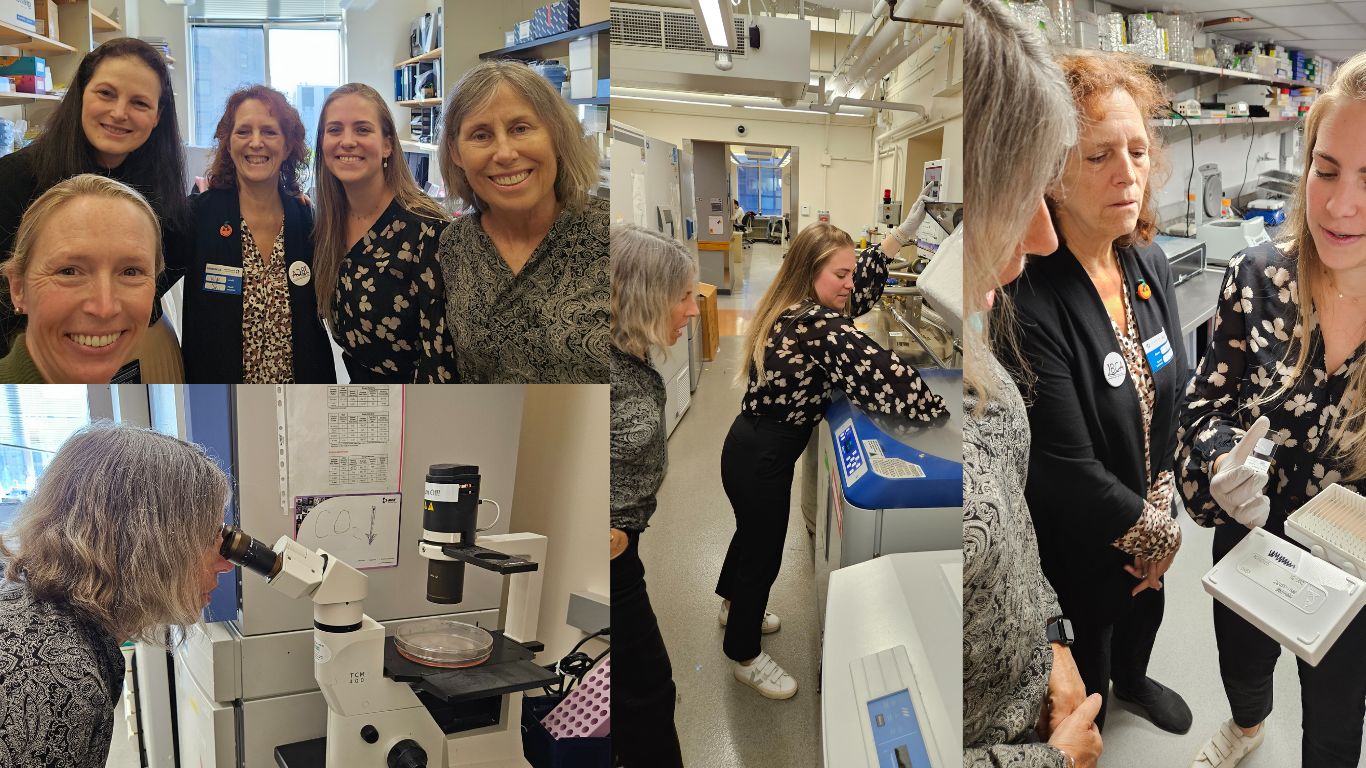
On Halloween, during October Breast Cancer Awareness Month, LBCA staff Laurie Hutcheson and Mason Mitchell-Daniels and patient advocate volunteer Beth Davis had the opportunity to visit with recent LBCA ILC research grant awardee Dr. Capucine Héraud. Capucine is a fellow in the Jeselsohn Lab for Translational Research at Dana Farber Cancer Institute. The lab is headed up by LBCA’s scientific advisory board member Dr. Rinath Jeselsohn.
We spent the morning with them in the lab first hearing from Capucine about the initial steps she is taking since being awarded in July the 2023 AACR-LBCA Invasive Lobular Carcinoma (ILC) Research fellowship. Her two-year study is attempting to advance the understanding of why some ILC tumors resist treatment with tamoxifen. With this grant, she will be following up on recent findings in preclinical models and clinical samples. She and her team will conduct her new research utilizing breast cancer tissue samples from the PELOPS clinical trial, in which tissue biopsies were taken from patients with early-stage Invasive ductal carcinoma (IDC) or ILC before and after two weeks of tamoxifen or letrozole treatment – two different hormone therapies used to treat breast cancer. They will study the patient tumor samples and isolate individual nuclei (the genetic center) from single cells. Then, they will analyze the chromatin accessible sites and transcriptome for each cell. (The transcriptome refers to the collective mRNA levels in the cell) and compare these cells in ILC vs. IDC.
After speaking about her study Capucine commented that she had never had patient advocates visit her in her lab and how important and helpful it is that we were there. She noted that it is inspiring to meet with the individuals who might ultimately be helped by her studies and how much she liked hearing and talking about our questions. She was particularly excited to meet Beth with whom she will be working as the ILC research advocate on her study as her work proceeds, and ultimately on writing up the results. She and Beth made plans for periodic check-ins and additional lab visits as the study progresses.
After briefing us, Capucine showed us around the one floor lab visiting all of the different areas where testing is conducted and explained a bit about how it works, describing how tumor samples are treated and the individual nuclei isolated for study. She showed us the ductal cancer cells that she had already obtained that are kept in cold freezers. And explained that there are several types of cold storage in the lab depending on the type of biologic material that is being kept and what actions are being taken with it. She shared with us the many steps that she must take each week working with the materials in the lab and viewing, measuring and documenting changes seen under the microscope in order to effectively see the study’s results. A definite highlight of the visit was having the chance to view the tumor cells under a microscope and watching as Capucine stuck her bare arm down into a deep freeze tank (-180) with the mist swirling around her to show us how specimens are safely stored for future research, quickly snatching it out to prevent frostbite.
“I was so very thankful to be included in the fascinating tour of the DFCI lab where they are looking into the unique way that LBC patients may become resistant to tamoxifen. And I was so impressed with the energy and optimism of this young scientist working on our behalf,” exclaimed Beth.”
Dr. Rinath Jeselsohn joined us towards the end of our visit to talk about the other ILC research she is aware of and the challenges that impede the development of clinical trials for lobular breast cancer. Rinath agreed that having patients visit the lab and to provide input into the study design is so helpful and meaningful to researchers. As advocates we felt very fortunate to have access to the research in action and to have such great researcher collaborators willing to explain all that is going on in a way that enabled us to understand the work enough to ask questions that were in turn helpful to them. “It was my first time in a research lab. It was fascinating and I felt it was such an honor to be there,” shared LBCA COO Mason Mitchell-Daniels.
“We know that all of our scientific advisory board members and ILC research grantees are eager to show their work to the lobular breast cancer patient advocates and LBCA will be trying to help all individuals who live near ILC researchers to make the connections so that they can enjoy a similar visit and opportunity to engage in real discussion of lobular research,” said Laurie Hutcheson. “We encourage anyone who wants information about LBCA’s SAB members who may have a lab in their geographic area to reach out to us so that we can help to connect you. “
We very much look forward to hearing and reporting more from Capucine and Beth about how the study evolves and especially about what new information is discovered about whether ILC responds differentially to tamoxifen, and why, and whether the team identifies new therapeutic targets for precision medicine for ILC.

